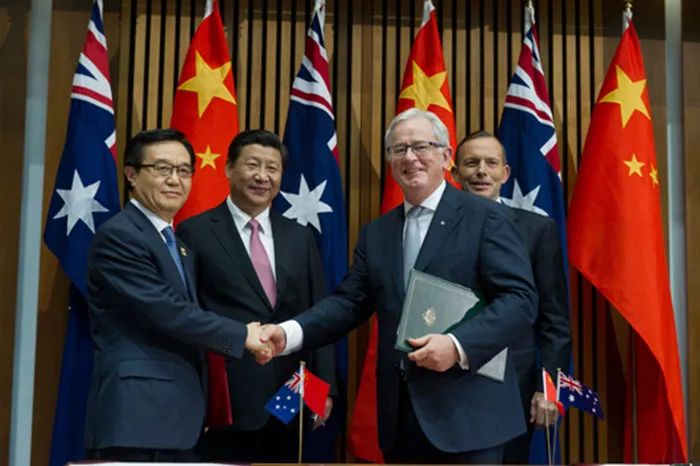
China Australia Free Trade Agreement (ChAFTA) History
Official signing of the China-Australia Free Trade Agreement (ChAFTA)
- April 2005: Negotiations on the China-Australia Free Trade Agreement (ChAFTA) were launched in April 2005 and lasted ten years.
- November 2014: During President Xi Jinping’s state visit to Australia in November 2014, he and Australian Prime Minister Tony Abbott jointly confirmed and announced the substantive conclusion of negotiations. The formal signing of the framework agreement laid the groundwork for the two countries to fulfil their respective domestic ratification processes and for the agreement to enter into force as soon as possible.
- 17 June 2015: China’s Minister of Commerce Gao Hucheng and Australia’s Minister for Trade and Investment Andrew Robb formally signed the China Australia Free Trade Agreement (ChAFTA) on behalf of the two governments, respectively, on 17 June 2015 in Canberra, Australia. Australian Prime Minister Tony Abbott attended the signing ceremony.
As of 2024, it is already the 10th anniversary of the China-Australia Free Trade Agreement Framework Agreement witnessed by President Xi Jinping and Prime Minister Tony Abbott.
Goods Area
Products accounting for 85.4% of export trade between the two sides will have zero tariffs immediately upon the entry into force of the agreement. After the transition period, Australia will eventually achieve zero tariffs on 100 per cent of tariff lines and 100 per cent of trade, while China will achieve zero tariffs on 96.8% of tariff lines and 97% of trade. This greatly exceeds the 90 per cent reduction level in general FTAs.
Service Area
Australia has committed to opening up its services sector to China on a negative list basis from the entry into force of the Agreement, becoming the first country in the world to make a commitment on trade in services to China on a negative list basis. The Chinese side opened up its services sector to the Australian side on a positive list. In addition, the Australian side has made special arrangements for the Chinese side in areas such as the holiday working mechanism.
Investment Area
The two sides will grant most-favoured-nation treatment to each other from the entry into force of the agreement; the Australian side will at the same time lower the vetting threshold for Chinese enterprises to invest in Australia and make facilitation arrangements.
Other Area
The agreement also provides for the promotion of exchanges and cooperation between the two sides in more than a dozen areas, including e-commerce, government procurement, intellectual property rights, competition and other "economic and trade issues of the 21st century".
China Australia Free Trade Agreement (ChAFTA) Progress
China Australia Free Trade Agreement (ChAFTA) Progress
Australia is a major developed economy with a large economic aggregate, a major exporter of global agricultural and mineral products, and has a mature market economic system and a matching legal system and governance model. The signing of the China-Australia FTA is an important and solid step in the process of accelerating the formation of a global-oriented high-standard free trade zone network, which will play an important role in promoting the deepening of China’s reforms and the construction of a new open economic system under the “new normal”. The China-Australia FTA is also another important FTA signed between China and another important economy in the Asia-Pacific region after South Korea. It is of great significance in promoting the Regional Comprehensive Economic Partnership (RCEP) and the Free Trade Area of the Asia-Pacific (FTAAP), as well as accelerating the process of economic integration in the Asia-Pacific region, and realising common development and prosperity in the region.
China’s food imports from Australia were valued at US$4.65 billion in 2015 and US$8.46 billion in 2022, an increase of US$3.81 billion, or 82%, in eight years.
Meat and products, grain and products, aquatic and marine products, fruits and products, dairy products, the import value of the top five, respectively, 31.51 billion U.S. dollars, 19.78 billion U.S. dollars, 19.39 billion U.S. dollars, 15.0 billion U.S. dollars, 13.93 billion U.S. dollars, year-on-year growth of -1.4%, 3.4%, 34.9%, 7.7%, 1.3%. The largest increase in imports was in aquatic and marine products, up 34.9% year-on-year.
The United States, Brazil, New Zealand, Thailand and Indonesia ranked among the top five importers, with imports of $16.86 billion, $12.85 billion, $10.89 billion, $10.09 billion and $8.70 billion, respectively, and year-on-year growth of -3.7%, 23.1%, 4.3%, 1.3%, and 3.8%, respectively. The largest increase in imports was in Brazil, with a year-on-year increase of 23.1%.
Guangdong Province, Shanghai, Beijing, Shandong Province and Zhejiang Province ranked among the top five cities in terms of imports, with imports of US$27.26 billion, US$21.38 billion, US$17.04 billion, US$14.07 billion and US$10.75 billion respectively. The city with the largest increase in imports was Zhejiang Province, with a year-on-year increase of 18.6%.
